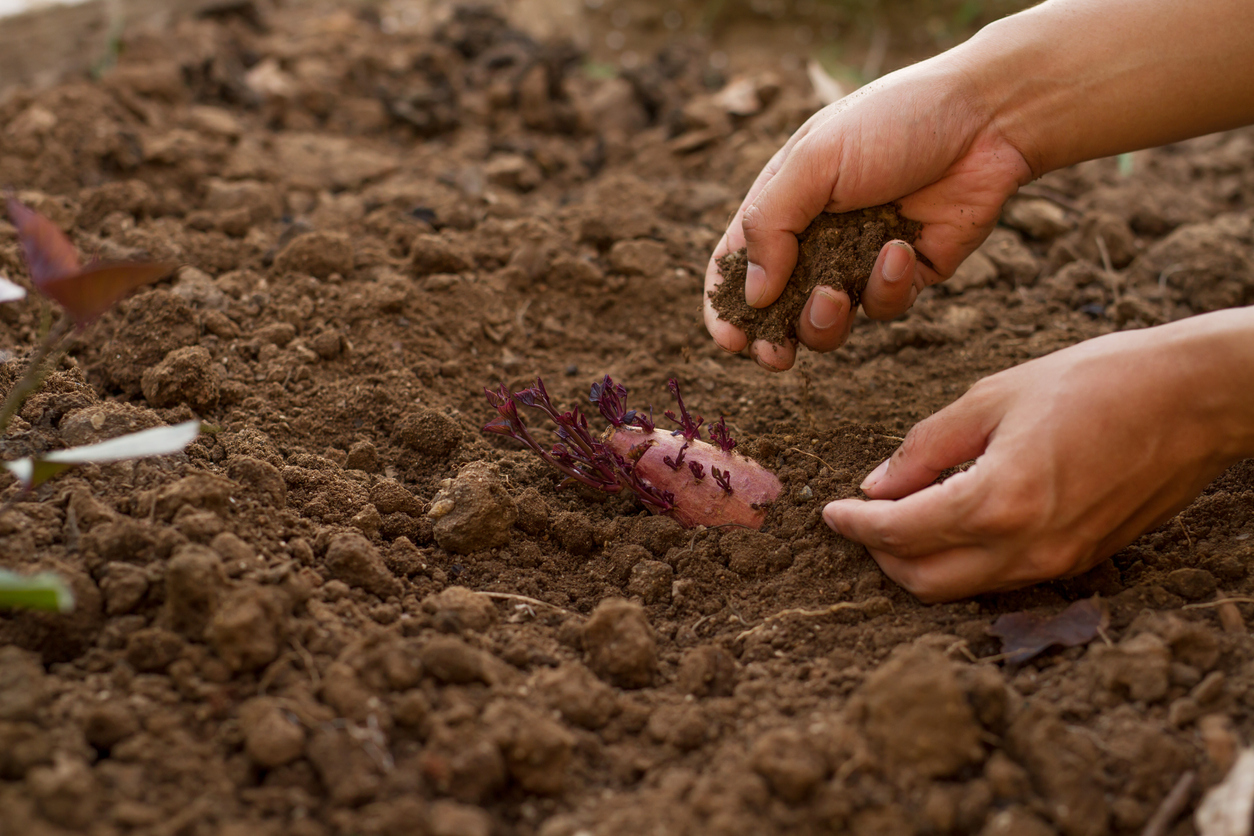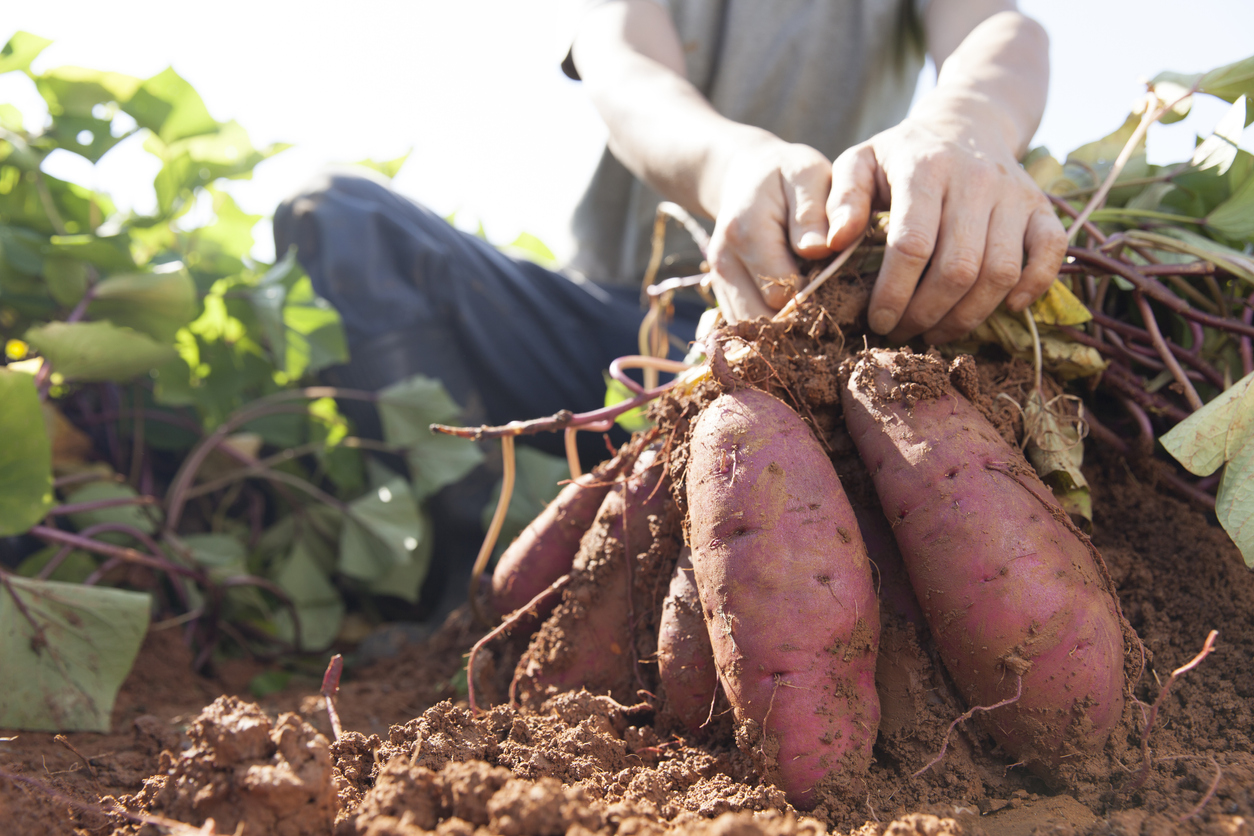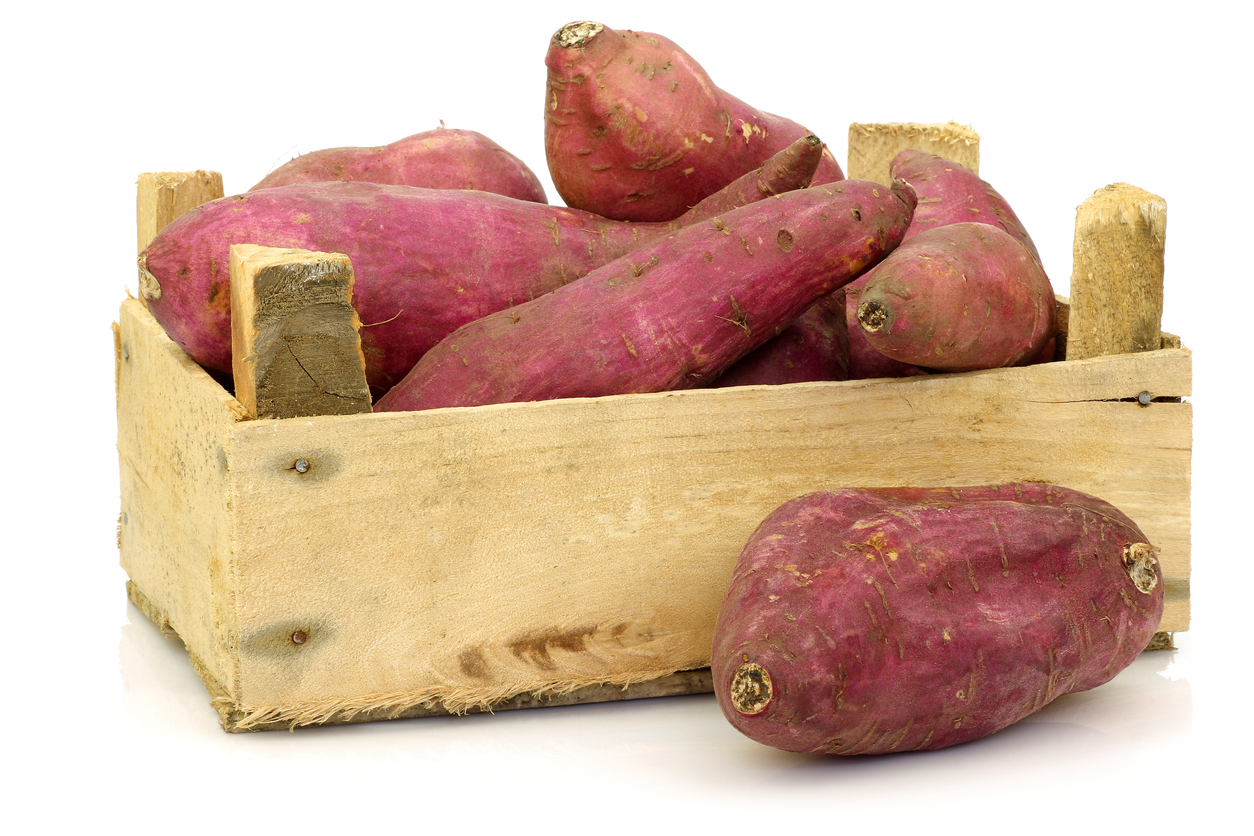

We may earn revenue from the products available on this page and participate in affiliate programs. Learn More ›
For gardeners who are looking to grow their own food, sweet potatoes can be a satisfying crop. They look pretty in the garden bed and, if stored correctly, can keep for up to a year. Because there’s an abundance of delicious sweet potato recipes, from traditional baked dishes to sweet potato fries, having sweet potatoes on hand can bring variety and color to the dinner table.
Growing them does take a measure of patience, as most reach maturity only after about 4 months. However, they are well worth the wait. Find out below how to grow sweet potatoes so you can reap the rewards in your garden.
RELATED: 12 Perennial Vegetables to Plant for Years of Fresh Produce
Growing Sweet Potatoes at a Glance
Common Name: Sweet potato
Scientific Name: Ipomoea batatas
Hardiness Zone: Zones 8 to 11
Soil: Loamy, quick-draining with pH 5.8 to 6.5
Light: Full sun
Water: Regular, at least 1 inch per week
Food: Low-nitrogen fertilizer
Propagation: Slips
Safety: Leaves can be toxic
Sweet Potato Characteristics
Rich in potassium, calcium, fiber, carotenoids, and vitamins A and C, sweet potatoes are one of the many superfoods you can grow yourself. This amazing vine has been cultivated in Peru since 750 B.C.—possibly earlier, with some archaeological records suggesting it was grown as a food source between 2500 and 1850 B.C. It is a lovely vining plant that, given enough space, looks beautiful in the garden.
Contrary to popular belief, the yam plant and the sweet potato plant are two entirely different plants, though both are harvested for their tubers, or roots. The tubers themselves are different. The yam (Dioscorea spp.) is the tuber of a tropical vine native to Africa, Asia, and the Caribbean. Somewhat sweeter than a sweet potato, it has rough brown or dark skin with purple, red, or white flesh.
The sweet potato (Ipomoea batatas) is a distant relative of the morning glory and even produces pretty purple flowers not unlike a morning glory. Sweet potato tubers typically have yellow, pale orange, deep orange, red, or purple skin, with the flesh ranging from pale yellow to deep purple—though the most commonly consumed varieties are orange.
Because the plant is so attractive, the sweet potato vine is also grown for ornamental purposes. It’s popular in hanging baskets and window boxes because of its trailing quality and decorative foliage that ranges from purple to bright chartreuse.

Recommended Sweet Potato Varieties
- Centennial: The most common sweet potato in the United States, this variety has coppery orange skin and bright orange flesh. It matures in just 90 days, so it is great for northern gardens.
- Jewel: Named for being the crown jewel of sweet potatoes, this sweet potato is a heavy producer and bred to be disease-resistant. They have pretty copper skin and bright orange flesh, and they mature in 115 to 130 days.
- Garnet: With red skin and orange flesh that stays orange even after baking, this sweet potato matures in 110 days.
- Georgia Jet: A good variety for gardens with a shorter growing season since it matures in 90 days. It has orange flesh and red skin, and vines can grow more than 3 feet long.
- Beauregard: This is a rich, yellow-orange sweet potato popular for its high yield and disease resistance. Its vines grow from 3 to 6 feet long.
- Porto Rico: A bunching or bush sweet potato, great for containers or smaller garden plots, it bears fruit that will mature within 90 and 110 days. Its flesh is lighter in color than Beauregard’s.
- Okinawan: An heirloom Japanese sweet potato that is pale on the outside, its light purple flesh turns a deep purple when cooked. High in antioxidants, these take 120 to 180 days to mature, so they grow best in temperate climates.
- Pumpkin Yam: An heirloom bushing sweet potato (not a yam), this variety produces large tubers with orange-red skin and bright orange flesh. It matures in 90 to 120 days.
Planting Sweet Potatoes
Having this beautiful plant in a vegetable garden is aesthetically pleasing, but they need plenty of room to spread. Bushing sweet potato varieties are more compact, but some vining sweet potatoes can sprawl to 6 feet or more.
RELATED: How to Cultivate the Perfect Soil for Your Vegetable Garden
When is the best time to plant sweet potatoes?
Sweet potato season takes place during the warmest months. Plant slips (which are sprouts grown from other sweet potatoes) in late spring, 3 to 4 weeks after the last spring frost. Soil temperatures should consistently be above 65 degrees Fahrenheit, and overnight temperatures should not dip below 55 degrees. This can be challenging for gardeners in northern or high-altitude climates with shorter growing seasons, so it might be best to choose a variety with a shorter harvest period, such as the 90- to 100-day varieties.
Where can sweet potatoes grow?
Sweet potatoes should be grown in a sunny garden plot that gets 8 to 10 hours of sunlight a day. They require well-draining, loamy soil. A good loamy soil is made up of a balance of sand, silt, and clay and has excellent drainage. This is perfect for sweet potatoes, which prefer soil moist but never soggy. If garden soil is heavier, it might be better to plant sweet potato slips in a raised bed or make raised rows for them in your sweet potato garden. This will help keep the soil temperatures warmer as well.
How do you plant sweet potatoes?
Because sweet potatoes are temperature-sensitive, they should ideally be planted on an overcast day with temperatures between 60 and 75 degrees Fahrenheit. If the soil is not enriched with a low-nitrogen, high-phosphorus fertilizer when planting, use an equivalent liquid fertilizer after following these sweet potato planting steps.
- Enrich the loamy soil with a low-nitrogen fertilizer before planting sweet potato slips.
- Make raised rows or mounds to help keep the slips warm. Both should be about 8 inches deep and ideally 12 inches wide.
- Space mounds or rows 3 feet apart.
- Break off the lower leaves on the slips, so only the top leaves remain.
- For optimal sweet potato spacing, place slips 12 inches apart from one another.
- Cover the roots and the stem up to the leaves.
- Water liberally for a week to 10 days.
Can you grow sweet potatoes in containers?
Growing sweet potatoes in containers is entirely possible. Start with a variety that requires less space, like Porto Rico, a bush sweet potato variety that grows shorter, more compact vines. The container should have plenty of drainage. Some gardeners use fabric containers for growing potatoes, which offer lots of aeration to the roots. Keep container-grown sweet potatoes in a warm place with full sun. Be sure the soil stays evenly moist, but make sure plants do not sit in water.
RELATED: 12 Climbing Vegetables That Are Perfect for Compact Gardens
Watering Sweet Potatoes
Sweet potatoes need regular water, but they can handle dry soil once established. Regular, thorough waterings are necessary after planting slips until they become established. Once established, sweet potatoes require about 1 inch of water per week, depending on the weather.
Water sweet potato plants in the evening or early morning to be sure the leaves dry off during the day. Stop watering in the last 3 to 4 weeks before harvesting sweet potatoes, as watering during that time can cause tubers to split.

Fertilizing Sweet Potatoes
The best fertilizer for potatoes is also the best fertilizer for sweet potatoes. The simplest way to fertilize sweet potatoes is to work a low-nitrogen, high-phosphorus fertilizer (5-10-10) into the soil before planting the slips. However, some gardeners prefer to add a liquid or water-soluble fertilizer at planting time and then every 4 to 6 weeks during the growing season. As with watering, stop fertilizing closer to the time of harvest.
Pruning Sweet Potatoes
Avoid pruning sweet potato vines at all, since the leaves feed the tubers and will help plants produce a robust harvest. If the vines become unruly, the best thing to do is to try to train them onto a trellis or back into the garden bed.
RELATED: Pruning Tomato Plants: 6 Mistakes Most First-Time Gardeners Make

Propagating Sweet Potatoes
Sweet potatoes are propagated from sprouts grown from other sweet potatoes known as slips. Most gardeners either buy slips from a garden center when planting season comes around or order them online. Because sweet potatoes take on average 100 days or more to mature and require soil temperatures above 65 degrees Fahrenheit, buyers should keep this in mind when timing online orders.
Slips can also be propagated from healthy sweet potatoes, which is an economical approach since a single sweet potato can produce around 50 slip sprouts. The sweet potato propagation process is fairly simple and not unlike sprouting a potato, or even an avocado pit.
- Scrub the sweet potatoes clean.
- Cut them in half or if they are large, in quarters.
- Fill a jar with enough water that you can suspend the sweet potato section half in and half out of the water.
- Use toothpicks to keep the section in place, similar to suspending an avocado pit in a jar.
- Keep the jars in a warm, bright place.
- When the sweet potatoes are covered in sprouts, remove them from the water to separate them.
- Carefully twist each small sprout off the sweet potato.
- Place the slips in a shallow pan of water with part of the stem in water and the leaves unsubmerged. Roots should start to emerge over time.
- Keep the water clean. Wait until the roots are at least 1 inch long before planting.
Safety Considerations
Although sweet potato tubers are not toxic to pets, the sweet potato vine can be poisonous, especially to cats. Unripe sweet potatoes are unsafe for dogs to eat, though they can eat fully ripe, cooked sweet potatoes in moderation.
Potential Pests and Diseases
Unfortunately, sweet potatoes are not immune to several fungi and pests. The best preventive step is to rotate your crops. Avoid planting sweet potatoes in the same place year after year, as fungi will pass on in the soil. Look for disease-resistant varieties, and buy your slips from a reputable grower.
Sweet potatoes can fall prey to whiteflies, wireworms, grubs, root-knot nematodes, and flea beetles. Perhaps a bigger problem than insects are several common fungi, with fusarium wilt, white rust, sweet potato scurf, stem rot, and black rot being the most common sweet potato fungal diseases. Unfortunately, the only viable option is to destroy infected plants.

Harvesting Sweet Potatoes
Harvesting sweet potato roots can be satisfying. Once the soil is loose enough, the sweet potato vine pulls up easily, revealing a string of several beautiful sweet potatoes at once. Don’t scrub potatoes after harvest; just shake or brush off dry dirt carefully. Wait until you are ready to eat the tuber to wash it, since the moisture will shorten its shelf life.
When is the best time to harvest sweet potatoes?
Ideally, harvest sweet potatoes before temperatures drop to 50 degrees Fahrenheit or lower. Sweet potatoes are warm-season plants that will grow until frost kills the vines, so they should be harvested as soon as this happens. If the roots stay in the ground too long after cold temperatures, they will rot.
How do you harvest sweet potatoes?
Although sweet potatoes can be harvested as soon as they look big enough to eat, you’ll know sweet potatoes are ready to harvest when the vines and leaves begin turning yellow. This is around 100 days after planting, but this will depend on the variety.
- Loosen the soil around the plant by digging at least a foot around and at least 6 inches deep.
- Cut back some of the sweet potato vine, but not the primary crown.
- Carefully pull up on the plant’s main crown to loosen the roots.
- A fresh sweet potato root bruises easily, so dig out soil as needed to make it easier to pull the roots out.
- Gently shake off excess dirt.
How do you cure sweet potatoes?
Cure sweet potato tubers before storing them to help them harden off. They’ll form a second skin that will keep them safe from nicks and bruises, and they’ll develop a sweeter flavor. The challenge is finding a place to cure them.
- Store the tubers in a warm place with high humidity for 2 weeks. Aim for 80 degrees Fahrenheit with 90 percent humidity; a greenhouse or table outside in the shade can work for storing sweet potatoes—provided hungry animal visitors cannot get to them.
- Arrange the sweet potatoes so they don’t touch.
- Discard any bruised sweet potatoes before storing.

How do you store sweet potatoes?
Always store sweet potatoes in a cool, dry, dark area. Place them in a wooden box or basket in the back of the pantry if it stays cool enough, or in a root cellar or basement. Do not store them in the refrigerator, where moisture and cold air will cause them to spoil faster. Many gardeners wrap their sweet potatoes in newspaper and then place them in a wooden box.
Sweet potatoes can also be frozen and stored for up to a year in the freezer. They must be peeled, boiled, and cooked completely first. Slice the sweet potatoes and add a little lemon juice to help preserve color, then store them in freezer-safe bags.
Looking for more healthy food to grow? Check out our guides on growing potatoes, pumpkins, and carrots.
